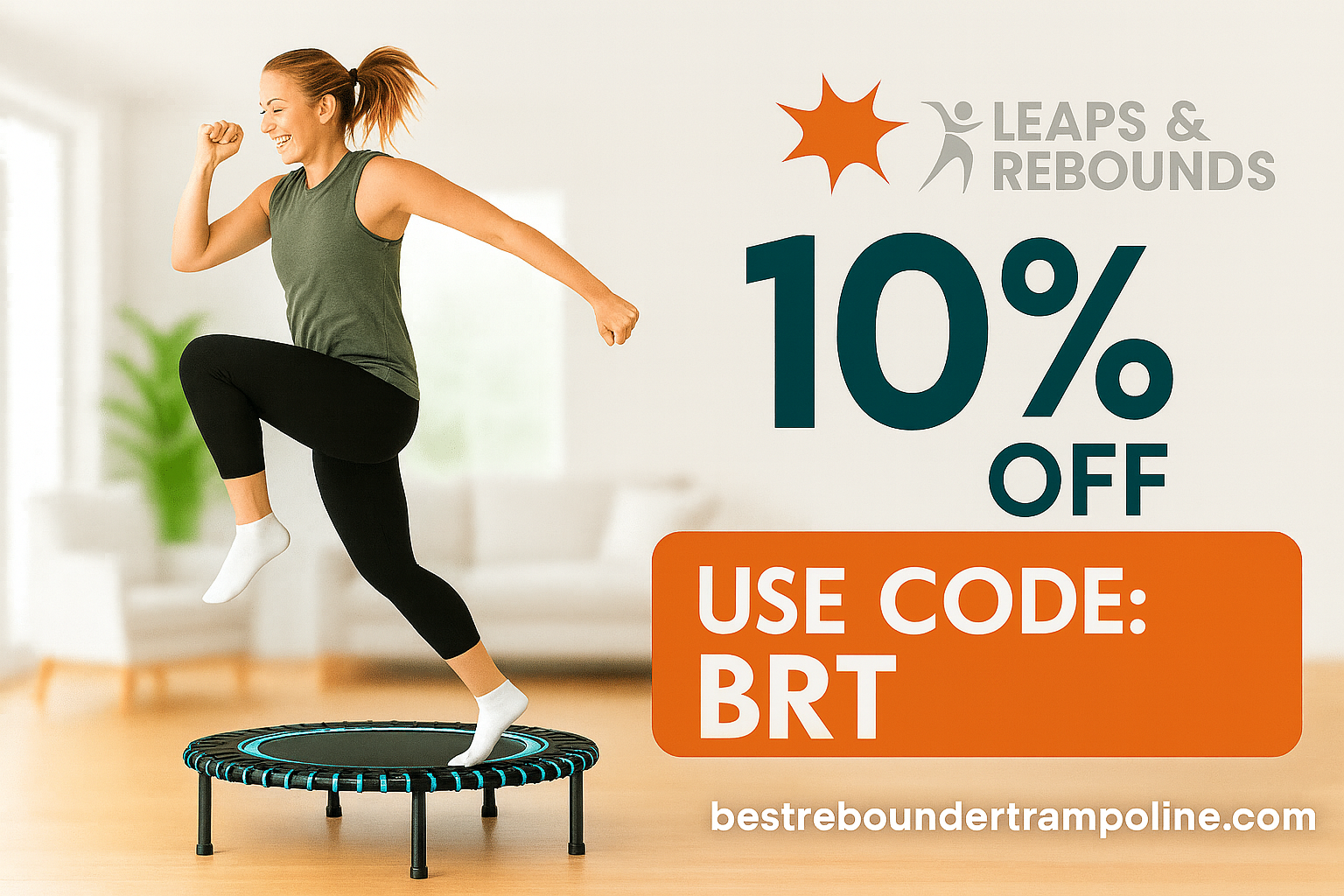Sign up for our mailing list at bestreboundertrampoline.com to receive regular offers
Understanding the Basics of Trampoline Rebounding
Trampoline rebounding, commonly known as just “rebounding,” is a low-impact exercise performed on a mini trampoline, also known as a rebounder. This activity offers numerous health benefits, including improved cardiovascular health, enhanced lymphatic function, and increased muscle tone. To get started with trampoline rebounding, it’s essential to understand its fundamental movements and techniques.
Basic Movements
- Health Bounce: A gentle bounce with feet remaining on the mat or barely lifting off, ideal for warming up and cooling down.
- Jogging in Place: Lift your knees as if you’re jogging, but stay on the trampoline to reduce joint strain.
- Jumping Jacks: Perform traditional jumping jacks, leveraging the trampoline’s bounce for added resistance and fun.
- Twists: Rotate your torso while keeping your legs together, engaging your core muscles for a full-body workout.
Rebounding primarily involves these simple actions, which can be adapted to suit your fitness level. Beginners can start slow with the health bounce and gradually incorporate more dynamic movements like jumping jacks and twists.
Safety Tips
- Ensure your trampoline is on a stable, flat surface to avoid accidents.
- Wear comfortable, non-slip shoes or opt for barefoot rebounding to enhance grip.
- Keep your knees slightly bent to minimize impact and protect your joints.
- Start with short sessions and gradually increase duration as your endurance improves.
Proper form and technique are crucial for maximizing the benefits of rebounding while minimizing the risk of injury. By adhering to these safety tips and consistently practicing the basic movements, you can enjoy a fun, effective workout that caters to all fitness levels.
Benefits of Rebounding on a Trampoline
Rebounding on a trampoline is an increasingly popular form of exercise due to its numerous health benefits. One of the most significant advantages is its ability to improve cardiovascular health. By consistently engaging in low-impact aerobic exercise, individuals can enhance their heart health and endurance without the joint strain often associated with running or other high-impact activities.
Improves Lymphatic Function
Another key benefit of rebounding is its positive effect on the lymphatic system. The up-and-down motion helps stimulate lymphatic flow, which can aid in detoxifying the body and improving immune function. This gentle, rhythmic movement encourages the efficient transport of lymph fluids, reducing the risk of inflammation and illness.
Enhances Balance and Coordination
Regularly using a trampoline can also enhance balance and coordination. The act of stabilizing oneself on an elastic surface requires the engagement of various muscle groups and improves proprioception—the body’s ability to sense its position in space. Over time, this can lead to better overall body control and a reduced risk of falls.
Supports Weight Loss
For those looking to manage their weight, rebounding provides an effective calorie-burning workout. This fun activity boosts metabolism and can help burn calories rapidly. Combined with a balanced diet, trampoline exercises are a fun and effective way to support weight loss goals and maintain a healthy lifestyle.
Essential Safety Tips for Trampoline Rebounding
Trampoline rebounding is a fun and exhilarating activity, but safety should always come first to prevent injuries. Whether you’re a seasoned bouncer or new to the trampoline world, understanding and implementing essential safety tips can make a significant difference. **Always perform a pre-jump check** to ensure the trampoline is in good condition. Look for any visible wear and tear, such as holes or frayed edges, and ensure that the springs are securely attached and covered with padding.
Use Proper Safety Gear
Wearing the right gear can drastically reduce the risk of injuries. **Always opt for protective padding and safety nets**, which can catch you if you lose your balance. Slip-resistant socks or shoes designed for trampoline use can also provide better grip. If you’re practicing advanced maneuvers, consider using additional gear like knee and elbow pads.
Establish Ground Rules
Setting and following strict rules is crucial for safe trampoline rebounding. **Ensure that only one person jumps at a time** to avoid collisions. Make it a rule to avoid somersaults or flips unless you’re trained and have proper supervision, as improper execution can lead to serious neck or spinal injuries. Educate children and novice jumpers about the importance of jumping in the center of the trampoline to maintain control and balance.
Supervision and Adult Monitoring
Active supervision is vital, especially when multiple individuals or young children are using the trampoline. **An adult should always be present to enforce safety rules** and to intervene in case of risky behavior. For added safety, consider surrounding the trampoline with a soft surface like grass or gym mats to cushion falls.
Sign up for our mailing list at bestreboundertrampoline.com to receive regular offers
How to Get Started with Trampoline Rebounding
Trampoline rebounding is a fun and efficient way to incorporate exercise into your daily routine. To get started, the first step is selecting the right trampoline. Look for a high-quality trampoline that is sturdy and features a durable mat. **Safety features** such as a protective padding and a solid frame are essential to ensure a secure workout environment.
Before beginning any exercise routine, it’s important to warm up your muscles. Start with some light stretching or low-impact activities to get your body ready for the rebound. Once you’re warmed up, here are a few basic moves to get you started:
- Basic Bounce: Stand with feet shoulder-width apart and bounce gently. Keep your core engaged and back straight.
- Heel Lifts: Alternate lifting each heel while bouncing. This move helps to improve balance and coordination.
- Knee Tucks: While bouncing, bring your knees towards your chest. This move targets the core and leg muscles.
As you progress, gradually increase the intensity and variety of your moves. Incorporating different patterns and exercises can help to keep your routine exciting and challenging. Remember to always listen to your body and avoid overexertion. **Consistency is key** to seeing results and maintaining a healthy rebound routine.
Rebounding can be a solo activity or something you enjoy with friends or family. Setting specific goals can also help you stay motivated. Whether it’s achieving a certain number of bounces per session or mastering a new technique, having clear goals can make your trampoline workouts more rewarding.
Effective Techniques to Improve Your Trampoline Rebound
Enhancing the rebound of your trampoline not only optimizes your performance but also increases your enjoyment and safety. One of the most effective techniques to improve trampoline rebound is to regularly maintain and inspect your trampoline’s components. **Check the springs**, bounce mat, and frame for any signs of wear and tear. Replace any worn-out springs and ensure that the bounce mat is free of holes or frayed edges. A well-maintained trampoline provides a more responsive and consistent bounce.
Another key technique involves incorporating specific exercises to build strength and agility. **Focus on leg workouts**, such as squats, lunges, and calf raises, to build the muscle groups that are crucial for a powerful rebound. Additionally, practicing controlled bouncing techniques on the trampoline can help. Start with basic bounces to get a feel for timing and rhythm before progressing to more advanced maneuvers. By training your body to use the trampoline’s energy efficiently, you can achieve higher and more controlled jumps.
When looking to improve your trampoline rebound, consider adjusting the tension of the springs. **Spring tension plays a significant role** in the performance of your trampoline. Depending on your weight and skill level, you might need to fine-tune the spring tension to find the optimal balance between firmness and flexibility. A trampoline that is too firm can be difficult to control, while one that is too loose may compromise your jump height. Experiment with different tension settings to discover what works best for you.
Lastly, don’t underestimate the importance of **correct jumping techniques**. Proper form and technique can drastically improve your rebound efficiency. Focus on maintaining an upright posture, using your arms to generate momentum, and timing your jumps to maximize the trampoline’s spring action. Practicing these techniques regularly can lead to significant improvements in your bounce quality and height.
Common Mistakes to Avoid When Rebounding on a Trampoline
When enjoying the benefits of rebounding on a trampoline, ensuring safety and efficiency is paramount. One common mistake is ignoring proper form and technique. Jumping without maintaining an upright posture or bending your knees slightly can lead to injuries and reduce workout efficacy. Always remember to distribute your weight evenly and engage your core muscles to stabilize your jumps.
Another frequent error is overlooking the importance of a proper warm-up. Skipping a thorough warm-up can strain your muscles and increase the risk of sprains and other injuries. Engage in activities such as stretching and light jogging to prepare your body for the exercise. This will not only help in preventing injuries but also enhance your performance and endurance during the rebounding session.
Many fitness enthusiasts also make the mistake of overestimating their abilities by attempting advanced moves prematurely. It’s crucial to start with basic jumps and gradually progress to more complex routines. Pushing yourself too hard too soon can lead to accidents and discourage you from continuing with the exercise. Instead, focus on building a strong foundation with simple jumps before advancing to higher-intensity moves.
Sign up for our mailing list at bestreboundertrampoline.com to receive regular offers
Choosing the Right Trampoline for Effective Rebounding
Selecting the perfect trampoline for effective rebounding is crucial for maximizing your workout efficiency and safety. When choosing a trampoline, one must consider the size and material. **A trampoline with a well-constructed frame and high-quality springs** can offer the required bounce and durability needed for regular use. Ensure that the trampoline is made from rust-resistant materials with a sturdy, non-slip jumping surface to prevent accidents.
It’s important to look at **the weight capacity and size of the trampoline**. Consider whether you need a mini trampoline for indoor rebounding exercises or a larger one for more extensive workouts. Mini trampolines, or rebounders, are excellent for those seeking a portable, space-saving option that can still provide an effective cardiovascular workout. Larger trampolines may be better for outdoor settings where space is not an issue and more vigorous activities are planned.
Another vital factor is the **safety features** of the trampoline. Look for models that come with padded edges and secure net enclosures when applicable. These features help in preventing injuries by cushioning falls and keeping users safely within the trampoline’s bouncing area. Additionally, ensure that the trampoline has a solid base to prevent tipping during high-intensity workouts.
When it comes to choosing the right trampoline, don’t overlook the aspect of **ease of assembly and storage**. Trampolines that are easy to set up and fold down can save you time and space, especially if you plan to use them in a multi-functional area of your home. Look for trampolines that come with clear instructions and necessary tools to facilitate quick assembly and disassembly.

William Liveman, also known as BounceBoss, is the visionary founder of Best Rebounder Trampoline. His personal journey through recovery using a rebounder has inspired the mission and vision of our blog. William is dedicated to sharing the benefits of rebounding and helping others find joy and health through this exercise. His leadership and passion drive the entire team to deliver the best content possible.




